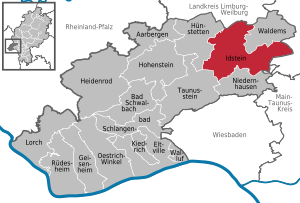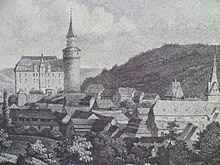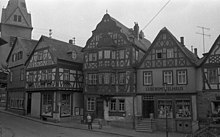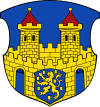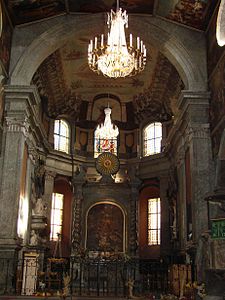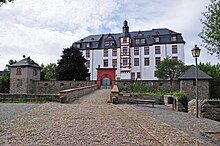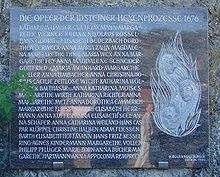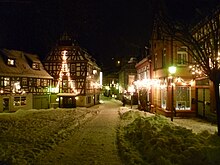Idstein
| coat of arms | Germany map | |
|---|---|---|

|
Coordinates: 50 ° 13 ' N , 8 ° 16' E |
|
| Basic data | ||
| State : | Hesse | |
| Administrative region : | Darmstadt | |
| County : | Rheingau-Taunus district | |
| Height : | 266 m above sea level NHN | |
| Area : | 79.69 km 2 | |
| Residents: | 24,997 (Dec. 31, 2019) | |
| Population density : | 314 inhabitants per km 2 | |
| Postal code : | 65510 | |
| Primaries : | 06126, 06127 (Lenzhahn), 06434 (Walsdorf), 06082 (Kröftel and Nieder-Oberrod) |
|
| License plate : | RÜD, SWA | |
| Community key : | 06 4 39 008 | |
| LOCODE : | DE IDS | |
| City structure: | 12 districts | |
City administration address : |
König-Adolf-Platz 2 65510 Idstein |
|
| Website : | ||
| Mayor : | Christian Herfurth ( CDU ) | |
| Location of the city of Idstein in the Rheingau-Taunus district | ||
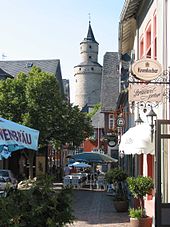
Idstein [ ˈɪtʃtaɪn ] is a town in the Rheingau-Taunus district in southern Hesse . It is located in the Taunus , north of the state capital Wiesbaden , and fulfills the function of a medium-sized center according to Hessian state planning .
In November 2015, Idstein was awarded the honorary title “ Reformation City of Europe ” by the Community of Evangelical Churches in Europe .
Since October 2016, Idstein has had the suffix “University City”.
geography
Geographical location
The old town is located between the two city streams, the Wolfsbach in the east and the Wörsbach in the west, at a height of around 280 meters above sea level on a ridge. This closes in the north of the old town of the castle and the castle rocks, behind which both streams converge. Remains of the settlement of the same name can still be seen at Wolfsbach, but it has been abandoned. The Gassenbach estate in the south of the city goes back to an old Gassenbach settlement; it has belonged to the Mechtildshausen domain for a few years .
To the west of the city, beyond the Wörsbach valley, there is another ridge from the Hohe Kanzel (592 m) over the Roßberg (426 m) and the Rügert (402 m) to the Rosenkippel (379 m), to the south the Galgenberg (348 m) forms another ridge to Dasbacher Haide. The federal motorway 3 and the high-speed route Cologne – Rhine / Main (in the Idstein tunnel ) run along the slope a little below the western height .
On the other side of the Rügert are the districts of Oberauroff and Niederauroff in the valley of the Auroffer Bach.
North of Idstein, the Wörsbachtal merges into the Goldenen Grund , fertile farmland that extends to the Lahn valley .
climate
The annual precipitation is 724 mm and is therefore comparatively normal, as it falls in the middle tenth of the values recorded in Germany. Lower values are registered at 45% of the measuring stations of the German Weather Service . The driest month is February, with the most rainfall in June. In June there is 1.6 times more rainfall than in February. Precipitation varies only minimally and is extremely evenly distributed over the year. Lower seasonal fluctuations are recorded at only 4% of the measuring stations.
Neighboring communities
Idstein borders in the north on the city of Bad Camberg ( Limburg-Weilburg district ) and the community Waldems (Rheingau-Taunus-Kreis), in the east on the community Glashütten ( Hochtaunuskreis ), in the southeast on the city of Eppstein ( Main-Taunus-Kreis ) , to the south to the community of Niedernhausen , to the southwest to the city of Taunusstein and to the west to the community of Hünstetten (all three in the Rheingau-Taunus district).
City structure
The city consists of the core city and eleven other districts:
| district | Residents |
|---|---|
| Idstein (core) | 18,240 |
| Dasbach | 308 |
| Ehrenbach | 307 |
| Ash cock | 776 |
| Booklet | 1,579 |
| Kröftel | 496 |
| Bilge cock | 252 |
| Niederauroff | 382 |
| Nieder-Oberrod | 546 |
| Oberauroff | 329 |
| Walsdorf | 1,480 |
| Woersdorf | 3,678 |
| total | 26,737 |
Until 1977 Idstein belonged to the Untertaunuskreis (district town Bad Schwalbach ), which was merged with the Rheingaukreis to form the Rheingau-Taunus-Kreis as part of the Hessian district reform . With around 26,700 inhabitants, Idstein is the second largest city in the Rheingau-Taunus district.
history
The Nack ring wall and the castle stables at Holdersberg Castle are evidence of the early settlement of the Idsteiner Land . Both plants are dated to the early Middle Ages by experts .
Idstein itself was first documented in 1102 as "Etichenstein" mentioned and received in 1287 by Rudolf von Habsburg , the town charter . In addition to the Hexenturm in the area of the old Nassau Castle, the city has a medieval town center with many half-timbered buildings. The oldest surviving house dates from 1410.
From its first documented mention in 1102 to 1721, Idstein was, with interruptions, the residence of the Counts of Nassau-Idstein and other Nassau lines . The Nassauer property was divided several times among the heirs and brought together again after the extinction of individual lines; from 1480 to 1509 there was an older line between Nassau and Idstein, later merged with Nassau-Wiesbaden and Nassau-Weilburg; and from 1629 to 1721 a younger line Nassau-Idstein.
In the 17th century Idstein was the scene of witch trials under the Protestant Count Johannes von Nassau and Idstein (1603–1677). The 39 people killed included the pastor's wife Elisabeth Hoffmann from Sonnenberg and Cäcilie Zeitlose Wicht , wife of the pastor Johannes Wicht from Heftrich . The victims of the witch persecution in Idstein were unanimously rehabilitated morally and socially and ethically by the city parliament until 2014.
In 1721 Idstein fell to Nassau-Ottweiler and in 1728 to Nassau-Usingen . It lost its status as a residential town, but became the seat of the Nassau archives and an upper office (see Office Idstein ).
The residential palace, which dates back to the 17th century, is used by the Pestalozzi School as a school building, supplemented by two new buildings below the palace.
From autumn 1806 the city of Idstein was part of the Duchy of Nassau , which was annexed by Prussia in 1866 . From the end of the 18th to the middle of the 20th century, Idstein was the location of an important leather industry. During the Second World War , many women were forced to work in the leather factories . In 1959 the dominant factory in the middle of the city center was closed for economic reasons. In 1956, a devastating flood inundated the factory. The area right on the edge of the old town remained undeveloped for a long time and was used as a parking lot until the 1980s. Today there are new commercial and apartment buildings around Löherplatz, which has also taken on the function of a market square. A leather factory is left in the Ehrenbach district. In the 19th century, fire syringes were manufactured by the syringe manufacturer E. Roth in Idstein , which were used in particular in the Nassau region.
The Kalmenhof educational institution in Idstein was included in the National Socialist “ euthanasia ” program: During the T4 campaign , the Kalmenhof served as an intermediate institution for the Hadamar killing institution . After the end of the gassings in Hadamar due to public protests, especially from the churches, Brandt himself murdered at Kalmenhof in the course of the Aktion Brandt ; the patients were killed here by, among other things, drug poisoning. The exact number of victims is still unknown, estimates amount to around 1,000 deaths. The doctor Mathilde Muthig (also known as Mathilde Weber ) had significant responsibility here .
The synagogue in Idstein was devastated during the November pogrom in 1938 . The Federal Archives' memorial book for the victims of the National Socialist persecution of Jews in Germany (1933–1945) lists 49 Jewish residents of Idstein who were deported and mostly murdered . In 2014, the first seven stumbling blocks were laid in Idstein to remember them.
Reports of abuse of young people under protection at the Kalmenhof have also come to light from the 1950s and 1960s .
Incorporations
On July 1, 1971, as part of the regional reform in Hesse, the previously independent municipalities of Ehrenbach, Eschenhahn and Niederauroff were voluntarily incorporated . Dasbach, Walsdorf and Wörsdorf were added on October 1, 1971. Heftrich, Kröftel and Nieder-Oberrod followed on December 31, 1971. The series of incorporations was completed with the incorporation of Lenzhahn on July 1, 1972 and Oberauroff by virtue of state law on January 1, 1977. Local districts with local advisory councils and local councilors were formed for all formerly independent municipalities and for the core city .
Population development
(as of December 31st)
|
|
politics
City Council
The city council is the highest body of the city. Its political composition is determined every five years in local elections by the city's electorate. Whoever has reached the age of 18 and is a German citizen within the meaning of the Basic Law or a citizen of one of the other member states of the European Union may vote . Everyone has to have been registered in the city for at least three months.
The local elections on March 6, 2016 produced the following results, compared to previous local elections:
| Nominations | CDU | SPD | FWG | Green | FDP | Distribution of votes | |
|---|---|---|---|---|---|---|---|
| 2016 | Share of votes a | 34.3 | 25.6 | 16.4 | 14.7 | 9.1 |

|
| Seats (of 37) | 13 | 10 | 6th | 5 | 3 | ||
| 2011 | Share of votes a | 35.5 | 29.6 | 12.3 | 18.7 | 3.9 |

|
| Seats (of 37) | 13 | 11 | 5 | 7th | 1 | ||
| 2006 | Share of votes a | 41.3 | 29.2 | 15.1 | 9.1 | 5.3 |

|
| Seats (of 37) | 15th | 11 | 6th | 3 | 2 | ||
| 2001 i | Share of votes a | 39.7 | 31.4 | 15.0 | 8.8 | 5.1 |

|
| Seats (of 37) | 15th | 12 | 5 | 3 | 2 | ||
| 1997 | Share of votes a | 34.8 | 27.2 | 23.5 | 9.8 | 4.7 |

|
| Seats (of 37) | 13 | 11 | 9 | 4th | - | ||
| CDU | SPD | FWG | Green | FDP | Distribution of votes | ||
37 city councilors and the city's local councils had to be elected for the legislative period from April 1, 2016 to March 31, 2021. Of the 18,781 eligible voters, 9,850 voted. As a result, voter turnout rose from 49.7% in 2011 to 52.4% in 2016.
badges and flags
|
Blazon : "The city colors are blue orange.
The city coat of arms shows a wall ring on a blue shield with a crenellated wall , inside of which there are two separate towers . In the wall itself there are two gates with open portcullis and between these there is a shield leaning against the wall with the coat of arms of the Counts of Nassau . The colors are: wall ring and towers: gold , tower roofs: red , portcullis: black , count shield on a blue background, lion and bricks: gold. " |
|
| Justification of the coat of arms: The coat of arms of the city shows a round castle with two towers and two gates , between which the coat of arms of the House of Nassau hangs. The latter shows a golden lion rising up against a blue background . |
The city colors are blue- orange. On the Idstein flag, the city coat of arms is in front of the colors orange and blue, the colors of the House of Orange-Nassau .
Town twinning
Idstein maintains city partnerships with:
-
 Lana , Italy
Lana , Italy -
 Uglich , Russia
Uglich , Russia -
 Zwijndrecht , Belgium
Zwijndrecht , Belgium -
 Şile , Turkey
Şile , Turkey
Furthermore, there is a citizen and a church partnership (Protestant parish)
-
 Moshi , Tanzania,
Moshi , Tanzania,
which, however, has not yet achieved the status of a town twinning.
In 1969 the first contacts were made to Vlijmen (now part of Heusden ). In 1972, an official partnership was recorded. In contrast to the other city partnerships, however, no partnership association was formed and the cooperation fell asleep. In October 2012, the partnership was formally ended on September 29, 2012 at the request of the Heusden municipality.
Culture and sights
Buildings
Large parts of Idstein's old town are now under monument protection. Many historical buildings have been preserved, among other things, because Idstein was largely spared from attacks during World War II.
Union Church
The Union Church, a simple building on the outside, unfolds its splendor on the inside. The building history of the church , originally consecrated as a collegiate church, goes back to the 13th century. A new Gothic building was built in the middle of the 14th century .
Unusually for a Protestant church - Idstein was Lutheran since 1553 - the ceiling of the main nave was completely covered with large-format oil paintings from the Rubens School in the 17th century . In 1917 the building, which until then was simply called the “City Church”, was given the name Union Church: It commemorates the church union in Idstein between Reformed and Lutherans in Nassau to form the Evangelical Church in 1817. In honor of this event, Idstein was given the title “ Reformation City of Europe “awarded by the Community of Protestant Churches in Europe .
Catholic parish church of St. Martin
Due to the influx of displaced people, the number of Catholics in Idstein increased after the Second World War. Therefore, instead of the neo-Gothic Magdalenenkirche, a larger church was built in 1965, which was consecrated to St. Martin. The architect Johannes Krahn designed a basilica made of natural stone masonry with a surrounding ribbon of windows under the ceiling. It received a Walcker organ in 1974 , which was replaced in 2006 by an organ from Orgelbau Mebold .
Residential palace
The present-day castle, built in the Renaissance style by Jost and Henrich Heer (Höer) for Count Ludwig († 1627) and his son Count Johann († 1677) using old structures, stands on a rock massif between the two city streams, which are built in the Renaissance style 1614–1634 unite behind Idstein. The castle rock was probably built on in the 11th century.
A bridged rock breakthrough separates it from the old castle area from the 11th century; An important inner-city connecting road now leads through the breakthrough.
During the reign of the last Prince of Idstein, Georg August Samuel von Nassau-Idstein (* 1665, † 1721), the interior of the building was given under the direction of Maximilian von Welsch . The partially lost stucco ceilings were made by Carlo Maria Pozzi. At the main portal is a large alliance coat of arms of Count Johann and his wife (around 1635).
The castle (since 1946 the Pestalozzi School ) can be visited as part of guided tours.
Castle and Witches Tower
The castle in the castle area from the archway building on the city side to the Hexenturm near the bridge to the castle was built between 1497 and 1588. With the redesign of the castle itself, this area also changed significantly in the 17th century and partly lost its defensive functions (no longer up to date). The hexenturm said keep (42 meters high, about 3 meters thick walls at only about 12 meters in diameter) is the oldest building Idstein. Dendrochronology drillings show that the tower was started around 1170 (instead of around 1350, as was long assumed). It was given its butter churn shape , built in sections, around 1500. (Building researchers see it as a rare time capsule because almost nothing was changed in the 20th century; in 1963 it was only given a new exterior plaster and small cement repairs on the inside.)
Witches or sorcerers were not imprisoned in the witch tower. This happened in a smaller tower, which no longer exists today. A memorial plaque for those murdered as witches was placed on a rock wall at the foot of the keep. Idstein was known for witch trials around 1676.
Höerhof
The Höerhof - also popularly known as the Toepferhaus - was built between 1620 and 1626 by the palace builder Henrich Heer. Among other things, it served as a hunting lodge and forestry office. The painter Ernst Toepfer lived here from 1911 to 1955 . The Höerhof is now home to a stylish hotel and restaurant with multiple awards and an idyllic inner courtyard. It represents one of the most magnificent half-timbered buildings in Idstein.
Building trade school
The municipal building trade school was built in 1892/93 according to a design by Emil Hoffmann, the then director of the building trade school, and expanded in 1910 according to plans by August Nabenhauer, a lecturer at the school. The building trade school was incorporated into the Wiesbaden University of Applied Sciences in 1971 , which gave up the Idstein site in 1993 in favor of Wiesbaden. The building has been used by the Fresenius University of Applied Sciences since 1995 .
Other historical buildings
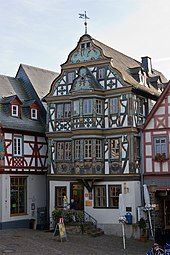
The old town center is small. A variety of partly lavishly painted and decorated half-timbered buildings distinguishes it, which already shows the Rhenish influences on the Hessian-Franconian half-timbered construction. The city center extends between the castle area with the approximately 50 m high witch tower and the Höerhof.
The town hall from 1698 stands directly at the archway building of the Nassau castle above König-Adolf-Platz , almost strangely above the passage that separates the old town from the castle; The carillon is also worth mentioning. A rock fall in 1928 destroyed the town hall, which was then rebuilt in 1932–1934.
König-Adolf-Platz is seamlessly surrounded by representative half-timbered houses, most of which date from around 1600. Next to the town hall on the left is the crooked house , which was renovated a few years ago and was built in 1727 by the major of the country militia Nicolay. At the exit of the square towards the Union Church, the richly decorated Killingerhaus was built in 1615 , which has served as a museum and tourist office since 1987. It is one of the most important half-timbered houses in Germany in terms of art history.
The rest of the old town center is also characterized by half-timbered houses and courtyards from the 16th and 17th centuries, some of which have been extensively renovated. This is particularly the case along Obergasse , which leads out of the city from König-Adolf-Platz and meets the old city wall at the level of Höerhof. A little below this is the Stockheimer Hof , which was built at the end of the 16th century as the seat of the Lords of Stockheim. After their extinction, the property came into the possession of the von Calm family from 1768–1776, which is why the associated site is now called Kalmenhof . Until 2005, the half-timbered building was in use by the Social Education Center SPZ Kalmenhof .
The last testimony to the former leather industry is the Gerberhaus , the former dry storage facility on the Wörsbach , on Löherplatz below the Union Church . Since the Middle Ages, the Löherplatz has been the location of the tanneries and leather preparation, because of the stench and water requirements associated with it, outside of the old town on one of the streams flowing through the Idstein. After extensive renovation, the tanner's house is now used for exhibitions and cabaret events.
To the east of the old town center, there is a baroque extension of the town starting from the market square that was built around 1700. In accordance with the ideals of urban planning of that time, the adjoining streets are clear, at right angles to one another, the half-timbered houses lining them are largely constructive and far less decorated than in the old town center. Building sins and major changes were omitted, instead it was restored several times. Thus, an impressive ensemble has been preserved due to its cohesion.
limes
The urban area was crossed by the Limes , which began in AD 86 . The area of today's city of Idstein was on the Germanic side. A striking testimony to the Limes is the replica of a watchtower (known as the Römerturm ) next to the road in the direction of Niedernhausen near Dasbach on the Dasbacher Höhe.
The Dasbach church tower is also said to be on the foundation of a Roman watchtower. In the municipality of the western neighbor Taunusstein , near Orlen, right next to the remains of the Zugmantel fort, there is also such a replica.
The Alteburg fort was located in the Heftrich district , but no remains of it can be seen.
On July 15, 2005, the Upper Germanic-Raetian Limes was declared a World Heritage Site by UNESCO .
Jewish Cemetery
Out of town is the Idstein Jewish cemetery from 1874.
War cemetery
During the Second World War, there were two reserve hospitals in Idstein - one in the castle and one in the Kalmenhof. When at the end of the war it was no longer possible to transfer people who had died in the hospital to their hometowns, they were buried in the Idstein cemetery. After the end of the war, the Volksbund Deutsche Kriegsgräberfürsorge built a central memorial in Idstein, where all war dead from the Untertaunus district were to be reburied.
There are a total of 250 graves at the Idstein war cemetery. Of those buried there, 234 people are known by name. 10 dead are civilians. There are also six graves with fallen soldiers and Russian prisoners of war from the First World War. Most of the dead at the Idstein war cemetery died after the fighting ended. There is evidence that prisoners from the Rhine meadow camps came to the Idstein hospitals.
Regular events
As an annual event highlight, the Hessen- Jazz Festival or, more recently, the Idstein JazzFestival has been drawing thousands of visitors to the old town streets for 20 years. On three days, the first weekend of the Hessian summer vacation, up to 75 different jazz groups play live and as an open-air concert on a dozen stages from Friday evening to Sunday .
In the Union Church, concerts by the Idsteiner Kantorei take place twice a year under the direction of Carsten Koch , such as Carmina Burana and Christmas Oratorio in 2009 . At the beginning of September there will be a “symphony concert for the Open Monument Day ”, played by the Nassau Chamber Philharmonic under Carsten Koch, which has a number of Beethoven's symphonies on the program. The Union Church is the venue for other concerts and also served as the venue for the Rheingau Music Festival with concerts by the vocal ensembles Chanticleer , ensemble amarcord and Die Singphoniker .
An annual choir concert takes place in the St. Martin Church , sung by the St. Martin Choir and the Martinis Chamber Choir under the direction of Franz Fink, like the St. Matthew Passion , in 1998 with Elisabeth Scholl , Andreas Scholl and Max van Egmond , in 2009 with Andreas Pruys and Klaus Mertens . Other concerts take place in the church, for example concerts with Graham Waterhouse , the duo program 2008 by Giora Feidman and Matthias Eisenberg or a concert by Kalevi Kiviniemi in 2010.
Although the town of Idstein only has a small vineyard, whose wine it is not for sale it only pours out on special occasions, there is an annual wine festival. The next larger wine-growing region is the Rheingau , which is in the same district as Idstein. Most of the wines at the wine festival come from there.
Every two years in the spring, the Idsteiner Hexenmarkt takes place in the area of the castle and palace , a show market with medieval crafts and an entertainment program, the name of which, like many other events and offers, refers to the city's landmark, the Hexenturm.
The nationally known " Alteburg Market " takes place three times a year on the site of the former Limes Fort Alteburg .
The youth center in Idstein also has a monthly event schedule with hip-hop, metal, DJ night, punk rock and offers, for example, live concerts by local bands at irregular intervals.
The Monkey Jump Festival has been taking place once a year since 2003 , with a large number of bands performing in the city's various pubs and restaurants.
Since 2004, the Idstein women's day “Women in Balance” has been held annually in the Gerberhaus with the participation of the equal opportunities officers of the city of Idstein and the community of Hünstetten.
Economy and Infrastructure
In 2016, the city of Idstein had an above-average purchasing power index of the national average (100 percent) with 118.1 percent (26,050 euros per inhabitant) .
traffic
Idstein lies on the German Half-timbered Road and the German Limes Road .
The city has a junction on the federal highway 3 north of Wiesbaden between Niedernhausen and Bad Camberg and a train station with direct connections to Limburg an der Lahn and Frankfurt am Main or Wiesbaden.
Since the construction of a city bypass, the B 275 has been running around the city in a wide arc. This enabled traffic in the historic old town to be largely calmed. Nevertheless, the volume of traffic in the city center is still high.
Instead of intersections, inner-city roundabouts improve the flow of traffic, sometimes significantly. The southern bypass, planned since 1981 and completed in the first construction phase in 2006, brings further relief. It opens up two new development areas. The second part, which relieves the inner city of traffic between Niedernhausen, the motorway junction and Taunusstein, has been completed since the end of November 2008. Around 60 percent of the almost ten million euros in construction costs will be borne by the State of Hesse. The remaining costs are borne by the city of Idstein and the Rheingau-Taunus district. In addition, a retention basin was built to protect the city from flooding.
railroad
The Idstein (Taunus) ( ⊙ ) and Wörsdorf ( ⊙ ) stations of the Main-Lahn-Bahn are located in the city of Idstein . The section in question was put into operation on October 15, 1877 by the Hessian Ludwig Railway. Trains run every hour on the Frankfurt / Wiesbaden – Niedernhausen – Limburg route into the evening hours. In Niedernhausen you can also change to the S-Bahn - line S2 in the direction of Dietzenbach via the Frankfurt and Offenbach S-Bahn tunnels and to Wiesbaden via the Ländchesbahn (sometimes also direct trains from HLB ). An extension of the S-Bahn to Idstein with the Niederseelbach stop is always under discussion, but has not yet been implemented. This is also assessed differently by the parties and partially rejected.
buses
The Idsteiner Stadtbus (de Idstaaner) serves two lines:
- 221 Bahnhof – Eisenbach – Taubenberg – Gänsberg – ZOB Schulgasse – Bahnhof (ex 401)
- 222 Bahnhof – ZOB Schulgasse – Gänsberg – Taubenberg – Eisenbach – Bahnhof (ex 402)
Another line, which will open up the gym in the old indoor swimming pool, the Taunusviertel and the Tournesol bath, has been in the planning for a long time and is expected to be implemented when the timetable changes in December 2016. In the course of this restructuring, the regional bus route 271 to Wiesbaden is to be routed with articulated buses via the B 275 instead of Wörtzgarten. The missing connection to the industrial area should be ensured with the new route of the city buses. The city bus is operated by Nassauische Verkehrs-GmbH (NVG). Mainly “Sprinter City 65” minibuses are used.
In addition, numerous regional bus routes operate in Idstein, which at the same time open up important areas in the city that are not served by the city bus.
- 220 Idstein– Niedernhausen –Oberjosbach (formerly 5460) (only during school hours)
- 223 Idstein – Heftrich – Glashütten – Königstein im Taunus (ex 403)
- 224 Bermbach – Idstein – Ehrenbach – Görsroth – Idstein-Bermbach
- 225 Bahnhof – ZOB – Hünstetten – Hahn– (Wiesbaden)
- 226 Bahnhof – ZOB – Wörsdorf – Wallrabenstein – Ketternschwalbach (formerly 103)
- 228 Idstein – Lenzhahn
- 230 Train station (/ ZOB) –Nassauviertel– Wörsdorf - Walsdorf - Bad Camberg (formerly 5465)
- 233 Idstein / Bad Camberg –Esch – Wüstems
- 234 Idstein / Esch – Heftrich – Kröftel
- 271 ZOB – Bahnhof – Am Wörtzgarten – Neuhof – Platte – Wiesbaden Hbf (formerly 5461)
By changing the route of line 230, it now serves the route Bahnhof-Hochschule-Zissenbach P + R every 30 minutes together with line 225.
Since the timetable change in July 2007, many journeys, especially on weekends or in the evenings, have been served by call buses . The bus service in Idsteiner Land is also served by the NVG. However, the NVG uses several subcontractors such as Wassum Reisen (Waldems), Paul-Reisen or Wahl-Reisen (both from Hünstetten) on the lines.
Bike trails
Several cycle paths lead through the urban area of Idstein .
- The German Limes Cycle Route follows the Upper German-Raetian Limes over 818 km from Bad Hönningen on the Rhine to Regensburg on the Danube .
- The motto of the Hessian long-distance cycle route R6 is from Waldecker Land to the Rhine Valley . The long-distance cycle path begins in Diemelstadt in the north of Hesse and runs to Lampertheim in the south. The total length is about 380 kilometers.
- The Hessian long-distance cycle route R8 is under the motto Westerwald-Taunus-Bergstraße with a length of approx. 310 km. It begins in Frankenberg (Eder) and then leads through the Gladenbacher Bergland , the Westerwald , the Taunus , Frankfurt am Main , the Odenwald and ends on the Bergstrasse behind Heppenheim .
Companies
Around 200 small and medium-sized mainly craft and retail companies characterize the commercial Idstein; 80% have fewer than ten employees.
The larger companies include Motorola , Jack Wolfskin , ElringKlinger , GLYN , Black & Decker GmbH and Dietmar Bücher Turnkey Construction .
The largest employer and significant economic factor is also the State Welfare Association of Hesse with the SPZ Kalmenhof , an institution for the disabled and youth welfare.
The local retail trade is in competition with the shopping centers in Limburg an der Lahn and Wiesbaden or generally with the Rhine-Main conurbation due to its convenient location on the Frankfurt / Wiesbaden – Limburg railway line and the Autobahn 3 .
Larger construction projects
In the course of the Hessentag 2002, several larger (re) building projects were carried out. After the construction of the Tiergartenspange, which connects the city center with Escher Straße and the residential area on Gänsberg, another part of the old town could be calmed down. In November 2008 the southern bypass was opened for public road traffic.
In addition to the city center, there are currently two further development or new construction areas:
- Nassau district (mixed area in the northwest of the city along the B 275)
- Taunusviertel (in the southeast of the city)
Larger individual projects since the Hessentag
- New construction of the primary school Auf der Au and the Erich-Kästner-Schule (completion: 2005)
- New construction of a police station (inner city, completion: 2006) in connection with the reconstruction of the district court (still under reconstruction)
- Reconstruction of the former Geldmacher site (diagonally across from the Kappus facility): fast food restaurant ( Burger King , not far from the long-standing McDonald’s ), auto parts and discount market (completion: June / August 2007)
- New building campus Europa Hochschule Fresenius (city center)
- New swimming pool (Tournesol leisure and wellness facility in the Nassau district, groundbreaking 15 February 2008, completion: 2009)
- New health center / hospital (southern bypass, completion: 2007/2008, move-in date after renovations: mid-2008)
- Kappus facility (at Kreisel train station ): medical center and discount market (completion: 2008)
- Driveway from the B 275 to the A 3 in the direction of Frankfurt (completion: April 2008)
Public facilities
- Evangelical parish of Idstein
- Evangelical parish Idstein-Heftrich
- Catholic Parish of St. Martin
- German Red Cross
- Idstein volunteer fire brigade
- youth Center
State institutions
education
- Alteburgschule Heftrich (primary school)
- Erich Kästner School (School for Learning Assistance)
- Feldbergschule (special school with a focus on "emotional and social development" as well as mentally ill students)
- Wörsbach School / formerly Franz Kade School (Wörsdorf Primary School)
- Primary school on the Au
- University of Applied Sciences Fresenius
- Limesschule (cooperative comprehensive school with upper secondary school level)
- Max-Kirmsse-Schule (special school for the practically imaginable)
- Montessori School Idstein (elementary school and integrated comprehensive school under construction)
- Taubenberg School (primary school)
- Pestalozzi School Idstein (grammar school)
- Rheingau-Taunus Adult Education Center
- Vitos Kalmenhof (institution of the State Welfare Association of Hesse)
hospital
In 2008, the hospital moved into a new, 22 million euro 90-bed house on an 18,000 square meter property on Robert-Koch-Strasse. The state subsidized 17.2 million euros (the previous 3 million came from the Rheingau-Taunus district, which had waived part of the purchase price for the former Idstein and Bad Schwalbach district hospitals).
swimming pool
An all-weather pool , partly prefabricated, was built in the Nassau district by mid-2010 for 19 million euros. The city subsidized the property on Bundesstraße 275, which cost more than two and a half million euros, and gives 500,000 euros annually to the operating costs. The bath, which was built and operated by the Tournesol company, has a dome that can be opened in good weather and includes a swimming pool, a fitness studio, a sauna area with four saunas, an infrared sauna, two steam baths, a laconium, a sauna garden, a whirlpool, a natural swimming pond and several relaxation areas. There is a bar between the play and leisure pool and the whirlpool, which can be reached from the water. A restaurant is also attached. The originally planned biomass power plant was not realized.
The old municipal swimming pool in Himmelsbornweg on Wolfsbach existed until April 2010 and had a toddler and baby bathing area, a sports pool with 25-meter lanes and a three-meter and one-meter diving board, a play and leisure pool with an outdoor area and a whirlpool on. The building has now been converted into a sports hall. An open-air swimming pool, also located on the site, was closed in the 1990s and the basin was backfilled after a considerable need for renovation had been determined, for which the city did not want to raise the necessary financial resources.
Personalities
Born in Idstein
- Johann Andreas Benignus Bergsträsser (1732–1812), teacher and entomologist
- Ferdinand Abt (1877–1962), sculptor
- Paul Böss (1890–1969), civil engineer
- Dietmar Bücher (* 1944), building contractor in Idstein, founder of the Dietmar Bücher company, turnkey construction
- Carl Deninger (1800–1859), entrepreneur and member of the state parliament
- Carl Jakob Frankenbach (1861–1937), Nassau painter and illustrator
- Henriette Maria Luise von Hayn (1724–1782), German hymn poet of the Moravian Brethren
- Christoph Heinrich (* 1960), art historian, museum director
- Karl Hill (1831-1893), opera singer
- Anni Jacob (1904–1972), doctor of chemistry, employee of Nobel Prize winner Alexander Robertus Todd
- Gustav Justi (1810–1879), German liqueur manufacturer and member of the state parliament
- Heinrich Kappus III. (1849–1926), building contractor in Idstein
- Wilhelm Kappus (1883–1966), building contractor in Idstein
- Albert Kaus (1891–1965), carpenter, together with Paul Cohaus, handed over the city of Idstein to American troops in 1945 without a fight
- Wilhelm August Kobbé (1802–1881), diplomat
- Karl Köllner (1790-1853), pietistic educator
- Gerhard Krum (* 1947), politician
- Marx Löwenstein (1824–1889), German-American multimillionaire
- Klaus-Peter Sattler (* 1941), composer
- Karl Adolph Gottlob Schellenberg (1764–1835), founder of the simultaneous school in the Duchy of Nassau and first pastor in Wiesbaden
- Walther Schultze (1893–1970), dermatologist
- Wilhelm Snell (1789–1851), professor of law and politician in Switzerland
- Friedrich August Wilhelm Wenck (1741–1810), historian
- Helfrich Bernhard Wenck (1739–1803), educator, historian, rector and consistorial councilor
Connected to Idstein
- Gerhard Achenbach (* 1936), chief physician at the Idstein district hospital
- Rudolf Baumbach (1807–1885), master builder and director of the Idstein building trade school
- Paul Cohaus (1896–1978), doctor and chief physician of the Idstein Hospital, together with Albert Kaus, handed the city of Idstein over to American troops in 1945 without a fight
- Johann Baptist Friedrich Anton von Franqué (1796–1865), doctor and scientist
- Loni Franz (1905–1987), home manager and youth carer at Kalmenhof
- Karl Christian Frickhöffer (1791–1845), German educator and vice rector at the teachers' college, Frickhöfferstrasse was named after him
- Friedrich Traugott Friedemann (1793–1853), director of the Nassau central archive in Idstein and member of the state parliament
- Wilhelm Nils Fresenius (1913–2004), chemist and managing director; The Fresenius University of Applied Sciences in Idstein is named after him
- Gottlieb Anton Gruner (1778–1844), educator and head of the teachers' college in Idstein, Grunerstrasse is named after him.
- Heinrich Herbert (1872–1956), civil engineer and director of the Idstein building trade school
- Franz Kade (1893–1987), Nazi educator and university lecturer, speaker and author. Founder of the Franz-Kade School in Idstein
- Max Kirmsse (1877–1946), curative educator, city councilor and teacher at the Kalmenhof
- Friedrich (called Fritz) Klein (1863–1940), doctor and chief physician of the city hospital, chairman of the Nassau Medical Association
- Kai Klose (* 1973), member of the Hessian state parliament
- Karlhans Krohn (1908–2003), sports teacher; Inventor of the game Indiaca , spent the last years of his life here
- Wolf Meyer-Erlach (1891–1982), theologian, university professor, university rector; 1951–1963 parish administrator in Idstein-Wörsdorf
- Julius Muthig (1908–1989), concentration camp doctor, practiced as a doctor in Idstein after 1945
- Mathilde Muthig (1909–1996, mostly called Mathilde Weber), NS doctor at Kalmenhof, lived in Idstein for many years
- Gabrielle Scharnitzky (* 1956), German actress
- Theodor Schliephake (1808–1871), philosopher, historian and university professor, was director of the Nassau State Archives in Idstein
- Ernst-Adolf Schmorl (1906–1964), Nazi doctor, later senior medical officer at the Kalmenhof
- Werner Schuster (1939–2001), doctor, medical computer scientist and politician
- Johann Jacob Schwenk (1859–1922), curative teacher, founding director of the Kalmenhof, city councilor
- Harry Seegebarth, " Harry von de Gass " (1942–2005), Idsteiner Original
- Sebastian Stoskopff (1597–1657), Alsatian painter, lived and died in Idstein
- Ernst Toepfer (1877–1955), painter
- Marius Weiß (* 1975), member of the Hessian state parliament
- The band Dirrrty Franz & the b-Side Boyz , which has songs about Idstein and also Idstein clubs in their repertoire.
Honorary citizen
- Christian Enders (1899–1984), senior forester a. D., made an honorary citizen in 1979
- Erivan Haub (1932–2018), owner of the Tengelmann Group , lived in Idstein for a few years. Appointed honorary citizen in 2008
- Hermann Müller (1935–2013), former mayor of Idstein
- Willy Schreier (1907–1988), former mayor of Idstein
literature
- Rouven Pons: For art and belief. The painting of the Martinskirche in Idstein under Count Johannes von Nassau-Idstein (1603–1677) (= publications of the Historical Commission for Nassau . Volume 83). Photos by Horst Goebel. Historical Commission for Nassau, Wiesbaden 2012, ISBN 978-3-930221-25-7 .
- Literature on Idstein in the Hessian Bibliography
- Literature by and about Idstein in the catalog of the German National Library
Web links
|
Further content in the sister projects of Wikipedia:
|
||
|
|
Commons | - multimedia content |
|
|
Wikisource | - Sources and full texts |
|
|
Wikivoyage | - Travel Guide |
- Internet presence of the city of Idstein
- Peter Faust, Stefan Gärth: Alt-Idstein. Introduction. In: alt-idstein.de. Peter Faust, 2004 (with a link to the interactive map “Im Stadtbering”, historical photos and documentation).
- Idstein, Rheingau-Taunus-Kreis. Historical local dictionary for Hessen. In: Landesgeschichtliches Informationssystem Hessen (LAGIS).
- Link catalog on the topic of Idstein at curlie.org (formerly DMOZ )
- Private website: Live images with a view over Idstein (webcam)
Individual evidence
- ↑ Hessian State Statistical Office: Population status on December 31, 2019 (districts and urban districts as well as municipalities, population figures based on the 2011 census) ( help ).
- ↑ On the importance of Idstein in the history of the Reformation see the section Union Church and the city portrait of the project Reformation Cities of Europe: Reformation City of Idstein. Germany. What belongs together grows together. In: reformation-cities.org/cities, accessed June 18, 2016.
- ↑ The award was made because of the local headquarters of the private Fresenius University . Hessenschau : Idstein is allowed to call itself “University City” ( memento from November 4, 2016 in the Internet Archive ). In: hessenschau.de. October 7, 2016, accessed on November 2, 2016: "The additional designation 'Hochschulstadt' was previously only used in Geisenheim (Rheingau-Taunus), Gießen and Marburg are called ' Universitätsstadt '." - "Additional designations" are provided by the Hessian Ministry of the Interior and for Sport awarded according to § 13 Abs. 2 HGO . Municipalities and counties. In: hessen.de, accessed on November 2, 2016.
- ^ Structural data ( memento of October 24, 2014 in the Internet Archive ). As of December 31, 2013. In: idstein.de, accessed on February 2, 2017. - As of December 31, 2016: 27,892 pop. In: idstein.de, accessed on February 2, 2017.
- ↑ Information on the website of the city of Idstein
- ↑ The witch hunt in Idstein , www.nassau-info.de, accessed February 14, 2020
- ↑ Ingrid Nicolai: Idstein Parliament rehabilitates Idstein victims of the witch madness ( Memento from November 8, 2014 in the Internet Archive ). In: wiesbadener-tagblatt.de. November 8, 2014, accessed February 2, 2017.
- ↑ Franz-Josef Sehr : The founding years of the volunteer fire brigade Obertiefenbach . In: Yearbook for the Limburg-Weilburg district 1995 . The district committee of the district of Limburg-Weilburg, Limburg 1994, p. 170 f .
- ↑ Memorial Book. Search in the name directory. Search for: Idstein - residence. In: bundesarchiv.de, accessed on February 3, 2017.
- ↑ Ulrike Holler : The Kalmenhof. The story of a reform home. In: hr-online.de. Hessischer Rundfunk , December 20, 2004, archived from the original on May 19, 2006 ; accessed on May 11, 2018 ( RTF; 59 kB ).
- ^ Press reports on the Heimkinder-Kongress ( Memento from February 18, 2012 in the Internet Archive ). Compiled from May 28 to June 3, 2004. In: vaeter-aktuell.papaserver.de, accessed on February 2, 2017.
- ^ Municipal reform in Hesse: mergers and integrations of municipalities from June 21, 1971 . In: The Hessian Minister of the Interior (ed.): State Gazette for the State of Hesse. 1971 No. 28 , p. 1117 , item 988; Paragraph 17. ( Online at the information system of the Hessian State Parliament [PDF; 5.0 MB ]).
- ↑ Law on the reorganization of the Rheingau district and the Untertaunus district (GVBl. II 330-30) of June 26, 1974 . In: The Hessian Minister of the Interior (ed.): Law and Ordinance Gazette for the State of Hesse . 1974 No. 22 , p. 312 , § 4 ( online at the information system of the Hessian state parliament [PDF; 1.5 MB ]).
- ^ Federal Statistical Office (ed.): Historical municipality directory for the Federal Republic of Germany. Name, border and key number changes in municipalities, counties and administrative districts from May 27, 1970 to December 31, 1982 . W. Kohlhammer, Stuttgart / Mainz 1983, ISBN 3-17-003263-1 , p. 377 f .
- ↑ main statute. (PDF; 36; kB) §; 5. In: Website. City of Idstein, accessed February 2019 .
- ^ Result of the municipal election on March 6, 2016. Hessian State Statistical Office, accessed in April 2016 . . In: statistik-hessen.de, accessed on February 3, 2017.
- ^ Hessisches Statistisches Landesamt: Results of the municipal elections of 2011 and 2006. In: statistik-hessen.de, accessed on February 3, 2017.
- ^ Hessisches Statistisches Landesamt: Results of the municipal elections of 2001 and 1997. In: statistik-hessen.de, accessed on February 3, 2017.
- ↑ Main statute (in the version of the 15th amendment statute of August 22, 2016) § 10 para. 1 city colors - city arms. In: idstein.de, accessed on February 2, 2017 (PDF; 37 kB).
- ↑ Main statute (in the version of the 15th amendment statute of August 22, 2016) § 10 para. 2 city colors - city arms. In: idstein.de, accessed on February 2, 2017 (PDF; 37 kB).
- ↑ Divorce instead of an anniversary celebration. In: FAZ . October 5, 2012, p. 54 ( limited preview ).
- ↑ Nassauische Union 1817. accessed on idstein.de, on February 3, 2017th
- ↑ Idstein is “Europe's Reformation City”. at idstein.de, accessed on February 3, 2017.
- ↑ The Mebold organ. 2006, II / 33. In: st-martin-idstein.de. Parish of St. Martin, archived from the original on June 4, 2016 ; accessed on May 9, 2018 .
- ↑ The Idstein war cemetery. History and background. In: kriegsgraeberstaette-idstein.de, accessed on February 3, 2017.
- ↑ St. Matthew Passion. In: st-martin-idstein.de. St. Martin Idstein, April 5, 2009, archived from the original on August 9, 2016 ; accessed on May 9, 2018 .
- ↑ structural data . City of Idstein, accessed on February 3, 2017 (as of December 31, 2016).
- ↑ Volker Stavenow: "I work until my last breath". Dietmar Bücher from Walsdorf founded his company "Turnkey Construction" 50 years ago. In: Wiesbaden Courier . July 6, 2019, accessed September 24, 2019.
- ↑ Alexander Robertus Todd: A time to remember. The autobiography of a chemist . Cambridge University Press, Cambridge [u. a.] 2009, ISBN 978-0-521-25593-6 , pp. 32 ff., 82 .
- ↑ (red): The Kappus family shaped the town of Idstein with small country-style villas. In: Wiesbadener Tagblatt . April 3, 2017, accessed April 4, 2017 .
- ↑ Fritz Koch: "Should every master be born in wedlock, also otherwise be honest change ..." Family and company history Heinrich Kappus III. from Idstein im Taunus. Ed .: Peter Birkel. Self-published by Peter Birkel, Idstein 2017, ISBN 978-3-935217-74-3 , p. 42 ff .
- ↑ Fritz Koch: "Should every master be born in wedlock, also otherwise be honest change ..." Family and company history Heinrich Kappus III. from Idstein im Taunus. Ed .: Peter Birkel. Self-published by Peter Birkel, Idstein 2017, ISBN 978-3-935217-74-3 , p. 99 ff .
- ^ A b Karl Heinz Schmidt: Idstein saved from being shot at. Remembering the brave act of Paul Cohaus. Born 110 years ago today . In: Idsteiner Zeitung . tape 108 , no. 295 . Idstein December 19, 2006, p. 10 .

